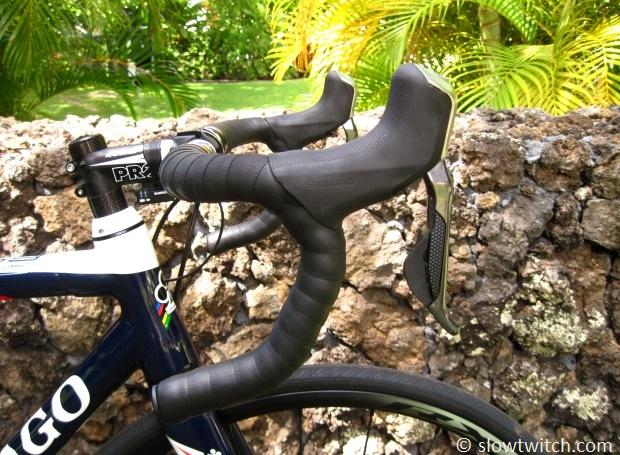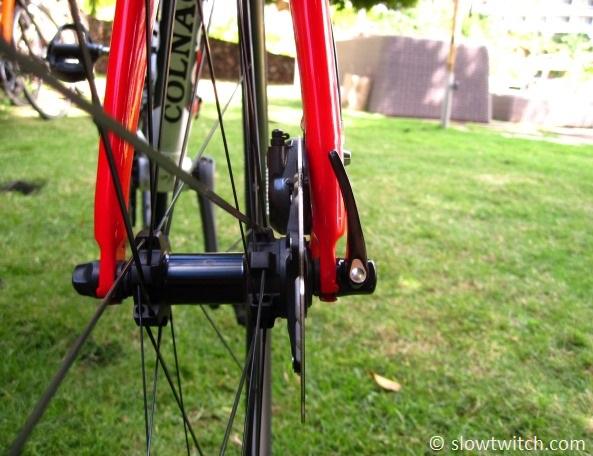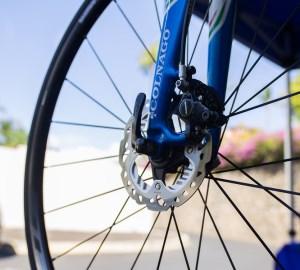Early this year, we had a chance to ride the latest 11-speed Shimano Dura Ace components. We also covered some of the new features of the setup and E-Tube wiring system (everything after the original 7970 Dura Ace Di2 has a newer wiring system, which Shimano calls “E-Tube”).
For 2014, Shimano is updating their Ultegra line to 11-speed in both mechanical (6800) and electronic (6870). They are also adding a non-series hydraulic disc brake system in electronic-only, called R785. Similar to what we’ve done in the past, I’ll lay out a cheat sheet for the numbers and what they mean (note that older 10-speed equipment will stop appearing on new bike sales as the 11-speed equipment phases in):
6700 – Mechanical 10-speed Ultegra
6770 – Electronic 10-speed Ultegra Di2
6800 – Mechanical 11-speed Ultegra
6870 – Electronic 11-speed Ultegra Di2
7900 – Mechanical 10-speed Dura Ace
7970 – Electronic 10-speed Dura Ace Di2
9000 – Mechanical 11-speed Dura Ace
9070 – Electronic 11-speed Dura Ace Di2
R785 – Electronic 11-speed with hydraulic disc brakes
We had the chance to ride both 6870 and R785 at a recent press event in Hawaii; check out our descent of Mt. Haleakala . Today we’ll go over the highlights of both products, and relay our experience with them so far.
Ultegra 6870 11-speed Di2
11-speed electronic is now at a lower price point. Unfortunately, we can’t say exactly what it costs; pricing is subject to the exchange rate between Japanese Yen and the US dollar, and will be finalized by the end of the year. Shimano representatives tell us that they expect the price to be slightly lower than 10-speed 6770 Ultegra ($2,400 for the complete groupset).

Aside from adding an 11th rear cog, what has changed? While the cogs are the same thickness as the 10-speed cassette, the chain has gotten slightly narrower and 20% stronger. The new cranks have the 4x110mm bolt pattern featured on Dura Ace 9070, and are available in ratios that Shimano calls “Rider-tuned” gearing. That’s fancy talk for “We offer more options than we used to”.
6870 chainring options:
53/39
52/36
50/34
46/36
6870 cassette options:
11-23
11-25
11-28
11-32
6870 crank length options:
165mm
170mm
172.5mm
175mm
The rear derailleur is now available in two distinct lengths – SS and GS. SS accommodates up to a 28 tooth rear cog, and the GS can handle a big 11-32 cassette.

The brakes are all-new, and feature a style much like the latest Dura Ace 9000 brakes. I have spent considerable time on the 9000-series, and they are definitely my favorite cable-actuated brake on the market in terms of overall feel and modulation. I hope and expect that these 6800 brakes would feel very similar, and have a pair to test long-term.

The big news for triathlon is this:

Yes, tri boys and girls, you now get your brake lever shifting at an Ultegra price. The previous 6770 10-speed system only featured bar-end shifters, unless you wanted to buy an aftermarket pair of Dura Ace carbon levers and a 5-port junction box. Now you get it right out of the box with an aluminum lever blade.
Standard Ultegra bar-end shifters come in the 2-button design (e.g. two buttons per shifter). Since everything is now E-tube cross-compatible, you can also use 1-button shifters if desired.

The drop bar shifters now feature a spare E-tube port, making them compatible with the auxiliary sprint shifter button. If you use the 5-port junction box, you can also use the full host of options that we detailed in our New Dura Ace Di2 Tech article (linked at the bottom of this page).
What about weight? Compared to 6770 with an external battery, 6870 loses 69 grams. If you opt for the new internal battery option, it is 126 grams lighter – also making it 9 grams lighter than an equivalent 6800 mechanical groupset.
All in all, new Ultegra 6870 Di2 is very much like its more expensive sibling, Dura Ace 9070 Di2. It is now fully programmable with all of the new and cool features, such as multishift (the ability to hold a shift button down and continuously shift), and manipulating shift speed. Don’t like which button shifts to an easier or harder gear? Swap them. Want to charge your internal battery without removing it? Just like the latest Dura Ace, now you can with Ultegra. While it is far from an entry-level price point, there is very little to not like about new 6870. My thumbs? They’re up.
Ultegra 6870 aftermarket ship date: December 2013
Pricing: TBD
R785 hydraulic disc brakes
Potentially the biggest story for Shimano in 2014, they’re now in the game of road hydraulic disc brakes. Not only that – it has been combined with Di2 electronic shifting.

It’s called R785. Similar to previous new introductions from Shimano, this is a ‘non-series’ product. What does that mean? There are no 105, Ultegra, and Dura Ace levels; there is only one. Shimano engineers were very frank about it – there’s only so much they could do in a given amount of time. They weren’t prepared to bring out multiple levels, so we get something that is effectively Ultegra Di2 ‘plus’.
The only products that are actually called R785 are the shifter levers and brakes. Everything else you need – the derailleurs, cranks, bottom bracket, chain, and cassette – must be purchased in standard Ultegra or Dura Ace versions.

The R785 shifters look very much like standard Ultegra 6870 Di2 shifters. They’re slightly taller to accommodate the master cylinder and fluid inside, but not nearly as tall as SRAM’s hydraulic levers, which also house mechanical shift internals.

The shift buttons feature the new larger and longer size, similar to the latest Dura Ace and Ultegra Di2.
The calipers feature all of Shimano’s latest brake technology, dubbed Ice Tech. The brake pads are attached to long backing plates, which have a large block of cooling fins at the end:

The rotors are also the latest Ice Tech design with cooling fins and ‘sandwich’ construction – the outside layers are steel, and the middle layer is heat-shedding aluminum.

Shimano is making some big claims about heat with this brake system. They say that the rotor cooling fins alone reduce peak temperatures by 50 degrees Celsius (122 Fahrenheit). The full combination of Ice Tech pads, finned calipers, and Ice Tech finned rotors offers a 200 degree Celsius (392 Fahrenheit) reduction compared to a system that lacks these features.
As a result, Shimano allows for the use of small 140mm rotors front and rear with no rider weight limit. Larger rotors have more surface area to contain heat, but carry the obvious downsides of increased weight and aerodynamic penalty. For comparison, SRAM’s new hydraulic disc brakes require a minimum of 160mm rotors for road use.

Most importantly – how do the brakes feel? Are they strong? Are they necessary?
Disc brakes have been an area of much heated debate (pun intended). Detractors say that they’re unnecessary. They add weight, carry an aerodynamic penalty, and aren’t needed for road riding conditions. Proponents say that disc brakes simply work better and are an inevitable next step – just look at mountain biking as an example.
Before I offer my thoughts, I’d like to encourage you to do one thing: try it before making a final verdict. As bike shops start carrying bikes equipped with hydraulic disc brakes, go for a test ride. If possible, do a ride that includes more stopping than one loop of the parking lot. Armchair quarterbacking only gets you so far, and first-hand experience always teaches you something. You may very well conclude that they’re the garbage or godsend that you expect – but you might also surprise yourself with a new opinion.
I personally went in to the test not expecting much of hydraulic road discs. I thought they would probably feel fine, but that’s it. After all, you can really tune a rim brake with the many pad choices on the market. With a good cable rim brake and pad, I’m generally a happy camper. I also like my Avid BB7 mechanical disc brakes, but they’re not that much better than rim brakes.

After riding around Hawaii for a few days on the R785s, here’s my conclusion: They’re outstanding. As in – really, really good. They far exceeded my expectations, and excelled in ways that I hadn’t even considered.
What is so great about the R785? In short – gobs of modulation. For those not privy to brake terminology, modulation is the ‘space’ you have between zero braking and full lock up. How much fine control do you have between those two extremes? How well can you feel the increase in braking power as you grab the lever harder? How linear is that braking power curve? In all of these areas, Shimano slams it out of the park.
The biggest improvement is in the very-light-to-moderate brake zone. With rim brakes, the typical tradeoff is between light braking feel and total stopping power. Either you get very good stopping power with poor sensitivity at low levels of braking, or very good light brake sensitivity with poor overall stopping power. The R785s were the only road brakes I’ve used that offered seemingly perfect performance in both cases, regardless of speed. Put another way, you don’t need good hand sensitivity or braking skill, because the brakes make the job very easy for you.

The control aspect is really hard to describe. Shimano calls their Di2 shifting ‘as easy as clicking a mouse’; I consider R785 to be the braking equivalent. While screaming down steep descents and winding turns, I was able to use a single finger for braking with incredible precision. Shimano PR representative, Nick Legan, commented that he had never seen a group of editors ride that fast in a large group right out of the gate. We were all on unfamiliar bikes, on unfamiliar roads, riding with people that we don’t normally ride with. Everyone’s confidence level seemed to be up a notch.
The reason I was so ecstatic about the brakes was beyond on-paper performance. In a strange way, they actually made road riding more fun. It’s easier. Pack riding is less nervous (this was unanimously agreed upon in our group).
One segment of road on our first day included an absolutely perfect series of winding downhill turns, followed by a tabletop that seemed to be placed there specifically for riding a bike over it. The brakes allowed us to hit a perfect exit speed… lift your weight ever so slightly… glide two inches over the pavement – and let out an uncontrollable laugh normally reserved for a perfectly groomed mountain bike trail. It was the most fun I’ve ever had on a road bike.
What about weight? What about AERO?!
I thought you’d never ask. For performance riding (e.g. racing), those are the two big questions.
Weight: Comparing the shifters and brake systems only, R785 adds 342 grams to standard Ultegra 6870. That’s not insignificant. If you really want to keep the weight down, you’ll have to go with Dura Ace derailleurs, cranks, and cassette.
That leads us to price – it ain’t cheap. If you do go with a full Dura Ace system, you’re obviously going to be spending a chunk of change. Replacement rotors will cost you $100 each – twice the price of an Avid HS1 rotor.
Aero: Yes, there’s that. Shimano – in their typical fashion – did not give us detailed graphs showing specific wind tunnel information. Here’s a look at the system from a frontal area perspective:

I’ve heard some different numbers thrown around as to what this penalty actually is, but I don’t have enough information to publish a definitive statement about the exact drag increase. This is clearly an area that we need to learn more, and will likely be the deciding factor for whether or not disc brakes make it onto triathlon bikes or serious road race machines.
Here’s where I am with the system. For cyclocross, it’s a total no-brainer. For road, I would personally use it in a heartbeat if I didn’t need to test so many rim brake wheels for my job. I don’t race road, so the weight and aero penalty don’t offset the increased fun factor and control.
For racing, I think the real question is whether or not the increased descending ability offsets the aero penalty. I can say with certainty that I rode faster downhill with R785s. Again – before you question it and confirm your position, I highly suggest that you try it. If you’re riding through the flat cornfields of America on a summer day, you’re absolutely better off with a lighter, cheaper, and more aerodynamic rim brake system. If you ride anywhere with serious descents, I think that these brakes are definitely worth considering. Shimano tells us that there are some professional road cyclists that are in support of disc brakes, and they tend to be those that are timid riding downhill. Would someone like Andy Schleck be faster overall using these brakes during a stage that included big descents?
I must reiterate: In no way do I think these brakes are an absolute necessity. We still see people swear that V-brakes and ceramic coated rims are ‘good enough’ for mountain biking. You know what? They’re right. The situation is no different with disc brakes and road. Cable rim brakes will always have a place, especially if we see a large enough body of data showing that disc brakes have a significant aero penalty. What I don’t want to assume is that the aero penalty will never shrink – or shrink enough for the descending advantage to be the next bottleneck in speed. Who knows?
R785 brake aftermarket ship date: December 2013
Pricing: TBD
R785 Technical Notes
-As with other disc brake systems, 135mm rear spacing is becoming the standard. Shimano had us aboard their mid-level RX31 disc brake wheelset with 135mm rear spacing.
-Note that some frames appear to still be figuring this situation out. I was riding aboard an Orbea Avant – a fine machine – save one detail. The rear dropouts are designed to work with both 130 and 135mm hubs, and I was unable to use my 11-tooth cog at all. For some odd reason, the rear derailleur hanger actually goes in towards the cassette, causing the chain to rub loudly in the 11:

-All of the hoses, fittings, fluid, and pads are interchangeable between R785 and Shimano’s mountain bike disc brakes
-You MUST use Shimano mineral oil. It has a boiling point above DOT fluid, at 532 degrees Fahrenheit.
-There are two pad options – resin and metallic. The former is the standard pad, and offers the quietest operation. The metallic pads are suggested for muddy conditions and will last longer, but can be louder. I rode only the resin pads.
-Shimano does offer a 160mm rotor option for those that want it. They say that there is no weight limit on the 140mm size in terms of heat safety, but the 160’s exist for those that want extra overall stopping power. Having ridden dual 140’s, I personally do not want or need the 160’s (at 170 lbs).
-Rotors are only offered in Centerlock design at this time. Shimano makes a 6-bolt XTR 160mm rotor, but it does not have the cooling fins.
--
Images #2, 6, 7, 9, 11, 12, 13, 15 © Eric Wynn / Shimano



